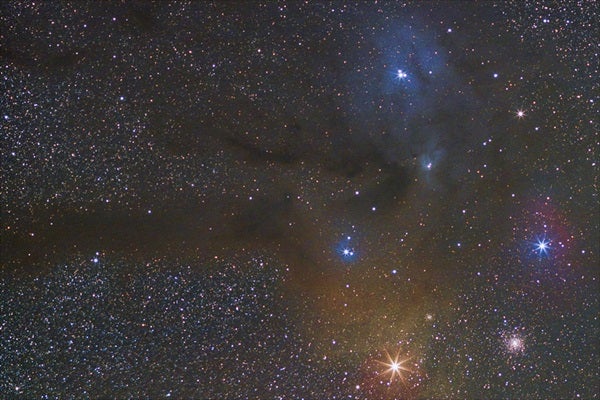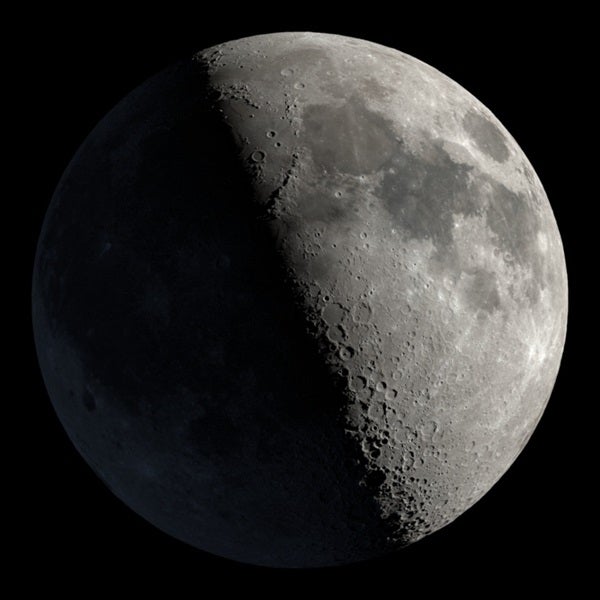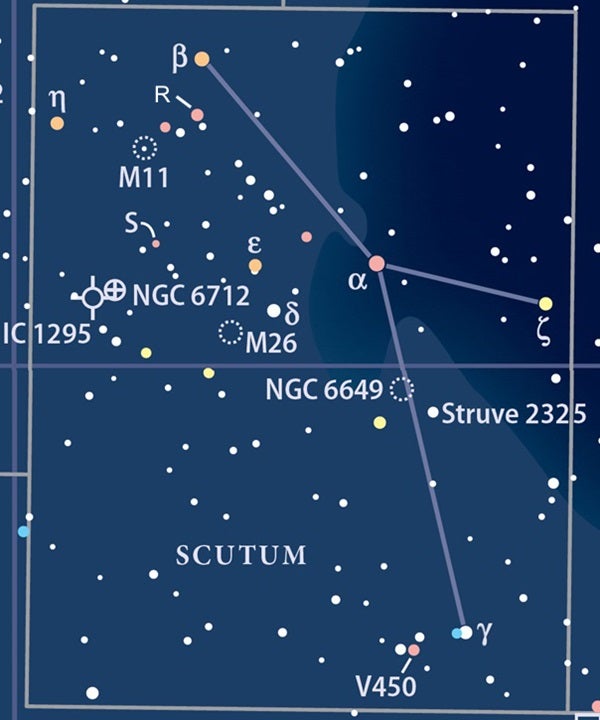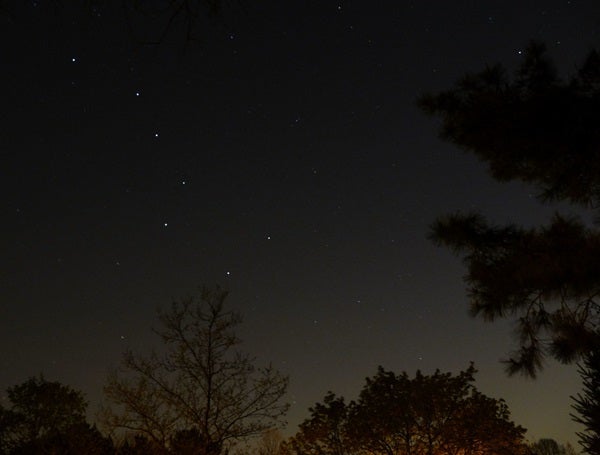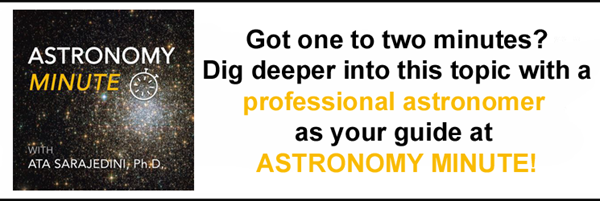Friday, July 1
Asteroids are numbered in the order in which they were discovered. So, lower-numbered asteroids were discovered first — and perhaps it should come as no surprise that these tend to be the biggest and brightest of the bunch. But this month, you can net a high-numbered asteroid with little effort: 387 Aquitania’s eccentric orbit is bringing it close to the Sun at the same time Earth is relatively far from our star. That means this small main-belt world is visible with a 3-inch scope under dark skies and only needs a 6-incher in regions with moderate light pollution. Such good alignments between Aquitania and Earth only happen every 100 years, so you won’t get another chance like we’ll have this month anytime soon.
Tonight, Aquitania sits a little less than 8° east of the 7th-magnitude globular cluster M14 in Ophiuchus. The asteroid itself is just over the border in Serpens Cauda, and roughly 0.5° east of a 6th-magnitude field star. Several 10th-magnitude globular clusters float nearby, including NGC 6535 4.5° to the asteroid’s north-northwest, IC 1276 2.6° to its south-southeast, and NGC 6539 3° to its south. The small world will move just a few degrees against the background this month, sliding southwest toward several open clusters; we’ll check back in with Aquitania in a few weeks.
Sunrise: 5:35 A.M.
Sunset: 8:33 P.M.
Moonrise: 7:35 A.M.
Moonset: 10:46 P.M.
Moon Phase: Waxing crescent (6%)
*Times for sunrise, sunset, moonrise, and moonset are given in local time from 40° N 90° W. The Moon’s illumination is given at 12 P.M. local time from the same location.
Saturday, July 2
Hopefully you’ve been able to enjoy the early-morning parade of planets currently providing a view across the solar system. The naked-eye planets still sit along the ecliptic in order of distance from the Sun in the predawn hours, but Mercury is quickly dropping out of sight as it moves toward a July 16 superior conjunction, when it will pass around the far side of the Sun. So, if you want to see this rare lineup before it disappears, this weekend may be one of your last chances.
This morning, Mercury is just 4° high in the east some 20 minutes before sunrise. Its small disk has brightened over the past few weeks and is now magnitude –0.8, so as long as you have a clear view of the horizon, you should be able to spot it. The next planet in line, brilliant Venus (magnitude –3.9) sits 13.5° west (to the upper right) of Mercury. To Venus’ lower right is the bright red giant Aldebaran, which may still be visible in the growing twilight.
Look roughly 43° west of Venus to land on magnitude 0.4 Mars. The Red Planet is just 13′ (0.2°) due south of 4th-magnitude Omicron (ο) Piscium this morning, though to catch this meetup, you’ll need to look 30 to 60 minutes earlier (at least) to catch them in a darker sky, before the star disappears as dawn begins to approach.
Continuing outward, Jupiter sits 20.5° west of Mars, just at the border of Cetus and Pisces. And Saturn caps off the line in Capricornus, another 43° west of Jupiter and still sitting near 3rd-magnitude Deneb Algedi.
Sunrise: 5:36 A.M.
Sunset: 8:32 P.M.
Moonrise: 8:37 A.M.
Moonset: 11:16 P.M.
Moon Phase: Waxing crescent (12%)
Sunday, July 3
With only a thin crescent Moon in the sky, this evening is a great time to explore the stunning Rho Ophiuchi region in the south, situated near — you guessed it — the star Rho (ρ) Ophiuchi in Ophiuchus the Serpent-bearer.
Pull out binoculars or use your small scope to take a tour of the 4°-wide Rho Ophiuchi region by first locating Antares, the bright red heart of Scorpius. From there, look about 1.3° north to find the star 22 Scorpii, which sits at the western edge of the dark nebula Barnard 44. Dark nebulae are clouds of cold dust that block starlight from any suns sitting behind them, so they appear as dark swaths of sky where there are few stars. B44 is roughly 6.5° long, bordered on its eastern edge by 24 Ophiuchi.
Rho Ophiuchi itself sits about 3° north-northwest of Antares. This star itself is an excellent small scope target, as it’s a binary system of two 5th-magnitude yellow stars separated by about 3″. Plus, the reflection nebula IC 4604 surrounds this stellar pair, lending the region around them a subtle glow.
Sunrise: 5:36 A.M.
Sunset: 8:32 P.M.
Moonrise: 9:40 A.M.
Moonset: 11:43 P.M.
Moon Phase: Waxing crescent (18%)
Monday, July 4
Earth reaches aphelion, the farthest point from the Sun in its nearly (but not quite) circular orbit, at 3 A.M. EDT. At that time, our planet will sit 94.5 million miles (152 million kilometers) from the Sun.
Let’s celebrate Independence Day with some fireworks. NGC 6946 is also known as the Fireworks Galaxy, thanks to the large number of supernovae astronomers have observed within it — eight in the last 100 years or so. This face-on spiral sits about 22 million light-years away in the far northern reaches of Cygnus, right at the constellation’s border with Cepheus. The high number of supernovae tell us that, in addition to lots of star deaths, there must be lots of star births in this galaxy as well. Thus, astronomers have classified NGC 6946 as a starburst galaxy.
Although this galaxy is cataloged as magnitude 9, its light is spread out over an area spanning 11′ by 10′. That means it appears relatively faint and you’ll want as large a telescope as you can manage to see it well. To find the Fireworks Galaxy, look 2.1° southwest of magnitude 3.4 Eta (η) Cephei, which itself sits just under 4° southwest of Alderamin, Cepheus’ alpha star.
Sunrise: 5:37 A.M.
Sunset: 8:32 P.M.
Moonrise: 10:42 A.M.
Moonset: —
Moon Phase: Waxing crescent (27%)
Tuesday, July 5
Rising in the hour before midnight, Saturn is perfectly poised for either late-night or early-morning observing. The latter is admittedly best, as the ringed planet climbs highest in the hours leading up to dawn.
Pull out your scope to enjoy this stunning planet in glorious detail. Saturn’s disk now spans 18″ and is surrounded by its famous rings, which stretch some 42″ across. They’re tilted just less than 13° to our line of sight — this angle will increase slightly through the fall, but then steadily decrease again until 2025, when they will appear edge-on.
Saturn is flanked tonight by several moons. Titan, the brightest at magnitude 8.5, sits some 45″ northeast of the planet. Tethys and Dione, both magnitude 10, are about 30″ west-southwest of Saturn, while Rhea (also 10th magnitude) is just over 1′ east-southeast of Saturn’s disk.
Sunrise: 5:37 A.M.
Sunset: 8:32 P.M.
Moonrise: 11:45 A.M.
Moonset: 12:06 A.M.
Moon Phase: Waxing crescent (36%)
Wednesday, July 6
First Quarter Moon occurs at 10:14 P.M. EDT. Because our Moon is up all evening, this is a popular phase to observe. Tonight, the Moon is in Virgo, 5° east of Gamma (γ) Virginis, also known as Porrima. This stunning double star is an easy-to-observe magnitude 3.5 and its components can be split with a small telescope. (This is not always true, however — the stars have an elliptical orbit that brings them close and then takes them farther apart again. Their last close approach, when they appeared just 3″ apart, was in 2005, and their next approach won’t occur for nearly 200 years.)
But the Moon is definitely our main attraction tonight, with half of its visible face now in sunlight. The terminator is the line dividing night from day on the surface, and it’s where you’ll find the most detail. Some features you may want to search out include the craters Hipparchus and Albategnius just south of the lunar equator, as well as Mare Frigoris in the lunar north. Fully illuminated now are features that include the Seas of Serenity, Tranquillity, Nectar, Crises, and Fertility. Look also for Vallis Alpes, a large, straight cleft in the Montes Alpes mountain range along the northeastern rim of Mare Imbrium.
Sunrise: 5:38 A.M.
Sunset: 8:32 P.M.
Moonrise: 12:49 P.M.
Moonset: 12:29 A.M.
Moon Phase: Waxing crescent (46%)
Thursday, July 7
Tonight, let’s travel back in time to 1795, when the variable star R Scuti in Scutum the Shield was discovered. One of the first variable stars ever identified, R Scuti is the American Association of Variable Star Observers (AAVSO) featured variable of the month for July.
R Scuti has an average magnitude of 5.2, but it can grow as bright as magnitude 4.5 and fade to a mere magnitude 9 (which requires binoculars to see). It has a period of 71 to 144 days — there are two values because it alternates between deep (magnitude 8 to 9) and shallow (magnitude 6.5 to 7) minima.
Finding this star isn’t difficult, even if you’ve never heard of the faint constellation Scutum. You can get there easily by star-hopping your way from a the much more famous — and brighter — Aquila, which is climbing in the southeastern sky after dark. This constellation’s brightest star is Altair, which blazes at magnitude 0.8. About 8.5° southwest of Altair is Delta (δ) Aquilae, a fainter — but still naked-eye — magnitude 3.5. From Delta, look 9.3° southwest to land on Lambda (λ) Aquilae, roughly the same magnitude as Delta (3.4). Now we’re getting close! From Lambda, look 4.7° due west. That’s magnitude 4.2 Beta (β) Scuti. And, finally, R Scuti is 1° south-southeast of this star.
Can you see it without optical aid, or do you need binoculars to find it? Compare and contrast R Scuti’s brightness to the other stars around it. Keep coming back every few weeks to watch how this star’s brightness changes over time.
Sunrise: 5:39 A.M.
Sunset: 8:31 P.M.
Moonrise: 1:55 P.M.
Moonset: 12:52 A.M.
Moon Phase: Waxing gibbous (57%)
Friday, July 8
With the gibbous Moon in the sky tonight, we’ll need a bright target for easy viewing. After dark, turn northward to find the familiar Big Dipper, which forms the hindquarters and elongated tail of Ursa Major the Great Bear. Most people can easily find these seven stars: four forming the bowl and three the handle.
But look closely at the second star from the end in that handle, right where it bends. Do you see one star or two? These are Mizar and Alcor, which shine at magnitude 2.3 and 4, respectively. They’re separated by nearly 12′, which means those with good eyesight (and good skies) can resolve them as two separate points of light. Alcor sits to Mizar’s northeast, which should be its upper right if you’re looking north in the few hours after dark tonight.
The pair’s wide separation is the first clue that they’re only a visual double and not a true binary star. Their distance is another: Mizar sits 83 light-years away, but Alcor is 82 light-years away; although that’s just 1 light-year apart, that’s certainly not close enough in space to form a binary pair. They are, however, part of a grouping of stars called the Ursa Major Moving Group, which are traveling through the Milky Way together on similar trajectories at similar speeds. This group includes not only Mizar and Alcor, but also Merak, Phecda, and Megrez in the Big Dipper, plus some 100 other suns.
Sunrise: 5:39 A.M.
Sunset: 8:31 P.M.
Moonrise: 3:05 P.M.
Moonset: 1:17 A.M.
Moon Phase: Waxing gibbous (67%)


